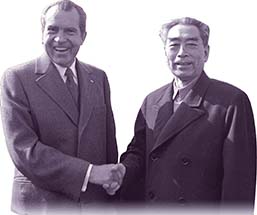SECTION 5: Nixon and the Cold War

▲ Nixon and Zhou shake hands in China in 1972.
WITNESS HISTORY  AUDIO
AUDIO
A New Era Begins
When Richard Nixon visited the People’s Republic of China in February of 1972, Premier Zhou Enlai greeted the President as he landed in Beijing. Once on the wind-swept tarmac, Nixon walked toward his host with his arm outstretched. Recalling John Foster Dulles’s refusal to shake Zhou’s hand at the Geneva Conference in 1954, Nixon made certain not to repeat the insult to the Chinese leader. Nixon remembered the occasion in his memoir:
“When I reached the bottom step, therefore, I made a point of extending my hand as I walked toward him. When our hands met, one era ended and another began.”
—Richard Nixon
Objectives
- Explain the thinking behind Richard Nixon’s foreign policy.
- Define Nixon’s foreign policy toward China and the Soviet Union.
Terms and People
- Henry Kissinger
- realpolitik
- Zhou Enlai
- Strategic Arms Limitation Treaty
- détente
NoteTaking
Reading Skill: Categorize As you read, describe Nixon’s Cold War foreign policies in dealing with China and the Soviet Union.
| China | Soviet Union |
|---|---|
|
|
Why It Matters As a presidential candidate, Richard Nixon had promised to end U.S. military involvement in the Vietnam War. Recognizing the potency of Soviet power and the increasing unwillingness of many Americans to pay the costs of containing communism everywhere, Nixon developed a new approach to the Cold War. His bold program redefined America’s relations with the two titans of global communism, China and the Soviet Union. Section Focus Question: How did Richard Nixon change Cold War diplomacy during his presidency?
Nixon Redefines American Foreign Policy
During his years in office, Richard Nixon fundamentally reshaped the way the United States approached the world. Before Nixon took office, most American leaders shared a common Cold War ideology. They stressed that there existed a basic conflict between democratic, capitalist countries and totalitarian, communist ones. They divided the world into “us” and “them,” and they established policies based on an assumption commonly held that “the enemy of my enemy is my friend.” Therefore, a country opposed to communism was, by this definition, a friend of the United States. Nixon and Henry Kissinger, his leading adviser on national security and international affairs, altered this Cold War policy approach.
At first glance, Richard Nixon’s partnership with Henry Kissinger seemed improbable. Nixon was a conservative California Republican, suspicious of the more liberal East Coast Republicans and exhausted with the political and strategic theories of Ivy League intellectuals. Kissinger was a Harvard-educated Jewish émigré from Germany and





